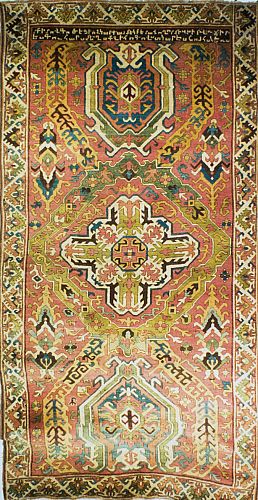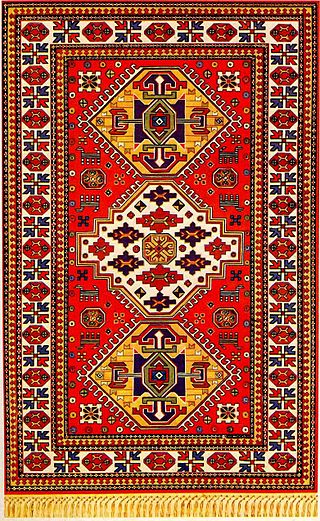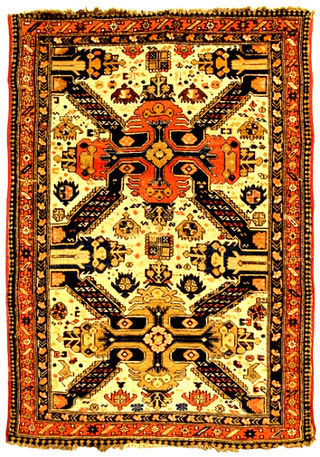
Arran carpets are a carpet variety.

Arran carpets are a carpet variety.
Barda was the center of Arran carpets production. From the second half of the 19th century these carpets began to be produced in Jabrayil weaving factories under the name "Arran", referring to the Arran region. It is known that in the 9th-10th centuries Barda was the center of this region. More recently, Arran carpets have been called "Jabrail" because they are widely produced in Jabrayil carpet weaving factories. [1]
The composition of the decorative pattern in the middle section of the Aran carpets consists of tasseled buta. These buta patterns - the main elements - are rarely but specifically placed in the middle field according to paisley-patterned carpets. Buta contains a description of birds and different shapes.
Arran carpets are woven in different formats. Density of knots is 4 knots per cm (160,000 knots per square meter). Pile length is 7 mm. [2]

A carpet is a textile floor covering typically consisting of an upper layer of pile attached to a backing. The pile was traditionally made from wool, but since the 20th century synthetic fibers such as polypropylene, nylon, or polyester have often been used, as these fibers are less expensive than wool. The pile usually consists of twisted tufts that are typically heat-treated to maintain their structure. The term carpet is often used in a similar context to the term rug, but rugs are typically considered to be smaller than a room and not attached to the floor.

A Persian carpet or Persian rug, also known as Iranian carpet, is a heavy textile made for a wide variety of utilitarian and symbolic purposes and produced in Iran, for home use, local sale, and export. Carpet weaving is an essential part of Persian culture and Iranian art. Within the group of Oriental rugs produced by the countries of the "rug belt", the Persian carpet stands out by the variety and elaborateness of its manifold designs.

Barda District is one of the 66 districts of Azerbaijan. It is located in the center of the country and belongs to the Karabakh Economic Region. The district borders the districts of Tartar, Agdam, Aghjabadi, Zardab, Agdash, and Yevlakh. Its capital and largest city is Barda. As of 2020, the district had a population of 157,500.

A Tabriz rug or carpet is a type in the general category of Persian carpets from the city of Tabriz, the capital city of East Azerbaijan province in northwest of Iran. It is one of the oldest rug weaving centers and makes a huge diversity of types of carpets. The range starts at Bazaar quality of 24 raj and on up to the incredibly fine 110 raj. Raj is the unit of knot density. It shows the rigidity of the rug which based on the number of strings used for the foundation of the rug. Strings materials are usually made of cotton or silk which is used for very fine rugs.
An oriental rug is a heavy textile made for a wide variety of utilitarian and symbolic purposes and produced in "Oriental countries" for home use, local sale, and export.

The Karabakh carpet, or Artsakh carpet, is one of the varieties of carpets of Transcaucasia, made in the Karabakh region.

Bergama Carpet refers to handwoven Turkish carpets, made in the Bergama district in the Izmir Province of northwest Turkey. As a market place for the surrounding villages, the name of Bergama is used as a trade name to define the provenience.

Anatolian rug is a term of convenience, commonly used today to denote rugs and carpets woven in Anatolia and its adjacent regions. Geographically, its area of production can be compared to the territories which were historically dominated by the Ottoman Empire. It denotes a knotted, pile-woven floor or wall covering which is produced for home use, local sale, and export. Together with the flat-woven kilim, Anatolian rugs represent an essential part of the regional culture, which is officially understood as the Culture of Turkey today, and derives from the ethnic, religious and cultural pluralism of one of the most ancient centres of human civilisation.

Hereke carpets are Turkish handmade carpets produced and sold in Hereke, a coastal town in Turkey. For a long time, they used to be produced only in Hereke, 60 km from Istanbul. The materials used are silk, a combination of wool and cotton, and sometimes gold or silver threads.

Ardabil rugs originate from Ardabil located in the province of Ardabil Province in northwestern Iran, 639 kilometers from Tehran. Ardabil has a long and illustrious history of Persian carpet weaving.
A Pakistani rug, also known as Pakistani carpet, is a type of handmade floor-covering heavy textile traditionally made in Pakistan and is used for a wide variety of utilitarian and symbolic purposes. Rug/carpet weaving is an essential part of Pakistani culture and Pakistani art.
Quba rugs and carpets are named for a town that is located in Azerbaijan Republic not far from the Caspian Sea; therefore, making Kubas a sub-division of Caucasian carpets. 1 Kuba is at once a city and an area that was formerly a Khanate of Azerbaijan.2 Within the Kuba genre itself, there exist many subdivisions including: Alpan-Kuba, Karagashli, Konaghend, Chi Chi, Perepedil, Seychour and Zejwa.3
Azerbaijani art is the art created by Azerbaijanis, other people that currently live on the territory of Azerbaijan, or people that used to live on the territory of Azerbaijan. They have created rich and distinctive art, a major part of which is applied art items. This form of art rooted in antiquity, is represented by a wide range of handicrafts, such as chasing (metalworking), jewellery-making, engraving, carving wood, stone and bone, carpet-making, lacing, pattern weaving and printing, and knitting and embroidery. Each of these decorative arts is evidence of the culture and the abilities of the Azerbaijan nation, and are very popular there. Many interesting facts pertaining to the development of arts and crafts in Azerbaijan were reported by merchants, travellers and diplomats who visited these places at different times.

The term Armenian carpet designates, but is not limited to, tufted rugs or knotted carpets woven in Armenia or by Armenians from pre-Christian times to the present. It also includes a number of flat woven textiles. The term covers a large variety of types and sub-varieties. Due to their intrinsic fragility, almost nothing survives—neither carpets nor fragments—from antiquity until the late medieval period.

Gasimushaghi carpets are Azerbaijani pile carpets of the Karabakh school of the Jabrayil group.

"Shabalyt buta" - Azerbaijani pile carpets part of the Karabakh group of the Karabakh type. The "Shabalyt buta" carpets belong to the complex composition of the Karabakh carpets. The main centres of production of the "Shabalyt buta" carpets were Jabrayil, Aghdam and Mugan. In an earlier period, carpets of the same pattern were woven at carpet weaving points located in the Iranian Azerbaijan, but they were rougher than the Karabakh ones. The silk carpets “Shabalyt buta” woven in Jabrayil were very popular.

“Shedde”, ) are Azerbaijani lint-free carpets part of the Karabakh group of the Karabakh type. These carpets were produced mainly in Nakhchivan, in Aghjabedi, Aghdam, Gubadly and Jabrayil districts of Azerbaijan.

Borchaly describes a sub-category within the Gazakh group of Azerbaijani carpets, even though the region from which they originate is now within Georgia. The name of this carpet is associated with the name of the Borchaly region, located to in southeastern Georgia close to the border of Gazakh district, Azerbaijan. Large villages of this region including Gurdlar, Akhurly, Kachagan, Sadakhly (Sashikhly), Dashtepe and Lembeli were once famous for carpet weaving, though in recent decades the art of carpet weaving has almost entirely died out, leaving only two known villages where Borchaly style carpets are still woven: Kosalar and Mughanlo. The population of Borchaly including the above-mentioned villages consists mainly of ethnic Azerbaijanis.

"Khila-Afshan" - pile carpets belonging to the Baku group of Absheron carpet weaving school.

Gollu-chichi or Gollu carpets — Azerbaijani carpets belonging to the Guba school of carpet weaving.